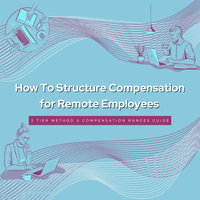
How to Structure Compensation
It has been proven that companies can effectively operate with a remote workforce. This guide provides an effective compensation strategy to meet the needs of a distributed workforce.
When establishing salary ranges, it’s common practice to use local market data aligned to office locations (e.g., San Francisco Bay Area or New York City). However, as employers transition employees to WFH and hire remote employees, it becomes too overwhelming to manage compensation ranges for all possible locations.
Instead of getting lost in the wilds of local market data, using a tier-based approach to manage and accommodate a geographically diverse workforce provides a simple, flexible and scalable approach.
Start by using U.S. National data as a baseline, and then apply the following:
- 115%: Add a 15% premium for cities like San Francisco, New York City, and surrounding boroughs.
- 110%: Add a 10% premium for cities like Seattle, Austin, and Boston.
- 100%: Use the U.S. National data cut for all other cities (even Chicago, Dallas, and Denver) and for jobs that are remote.
While establishing the ranges, decide the percentile of the market data to target for resource-constrained jobs (e.g., technical jobs) and non-resource constrained positions. For example, companies typically target the 65th or 75th percentile as the midpoint of the range for technical positions like Software Engineers and Product Managers, and the 50th percentile for jobs that are less difficult to hire and retain top talent.
Then, using the midpoints, develop salary ranges for each role in each tier. To set the minimum, take 85% of the midpoint, and for the maximum, 115% of the midpoint.
To ensure consistency in how offers and pay decisions are made, share the ranges with recruiters, hiring managers, and leaders.
Salary Usage Guideline:

- Low Range: Target between the minimum and midpoint of the range when the employees/candidates are new to the role or newly promoted to the role.
- Mid Range: Target the midpoint for employees/candidates who are fully competent in their role and job level, and consistently meet performance expectations over a period of time.
- High Range: Target between the midpoint and maximum for employees/candidates who are experienced, have a special skill set, and/or are top performers. Employees who are typically ready for promotion are likely at the top of the range.
At this point, if you haven't conducted job leveling, now is the time. Calibrating your employees’ job levels against your newly established ranges helps establish a good foundation to assess employee pay.
Using compa-ratios provides a consistent way to review individual employee pay is given market rates vary by job, level, and geographic location.
To calculate compa-ratios for each employee, divide their salary by the midpoint of the range for their job. A 100% compa-ratio means they are right at the market midpoint. Compa-ratios between 85% and 115% are considered within the competitive range. Having reliable compensation market data and structure helps back up that your company offers competitive pay.
Paying fairly doesn't mean everything has to be complicated.
About Kamsa
The team at Kamsa are experts at establishing career paths and building compensation programs for companies, and our compensation software makes compensation painless. If you would like to learn more about how Kamsa can support your compensation needs, contact [email protected]


